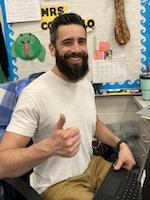


Attendees will walk away with the knowledge and resources needed to start a 3D printing program in their classroom from scratch. We’ll address a variety of situations, including: How to think in 3D, starting a program with no 3D printer, how to get buy-in from your administration, free resources and digital tools that work across all devices (iPad, Chromebook, etc), and how to go from digital project to print.
*OBJECTIVE 1: Build a fundamental understanding of the basics of 3D printing and design.
-PURPOSE: With a basic understanding of 3D printers and their capabilities, how students can design in 3D, and where to find free resources, attendees will be able to start a 3D program in any classroom, even without a 3D printer.
*OBJECTIVE 2: Develop a basic understanding of Tinkercad
-PURPOSE: Attendees will develop a far better understanding of how to use Tinkercad with a hands-on approach. Our first task will be to complete the initial Tinkercad tutorial. Once complete, attendees will complete one of our student projects, gaining the student’s perspective.
*OBJECTIVE 3: Cover 3D printer best practices.
-PURPOSE: 3D printing involves a lot of failed prints, troubleshooting, and problem solving. To give attendees the confidence to move forward on their own, we’ll share what we’ve learned. We’ll have a take away that covers the basics, including tools, best practices, and tips.
Part A - Classroom (~30 min)
*Where to start?
-What is 3D printing?
-What 3D printer is the best for my classroom? (Covered in Part B)
-What tools do I use to make 3D models to print?
-Where can I find ready made 3D models?
-Do I need a 3D printer to start a 3D design program?
*Vocabulary
-Go over the basic terminology needed to simply, and accurately, discuss the 3D design and print process. We’ll have a cheat sheet we’ll share via Google Drive for attendees to reference back to, hand out to students, etc.
*Quick Ideas/ Projects (INTERACTIVE)
-How to determine the best project for your class/grade level
-Where to go for inspiration
~Our Google Doc will contain links; sample projects from Thinkercad, etc.
-Student Ideas (Excellent area to discuss empathy and how to positively impact the lives of others) (PRESENTER TO ATTENDEE INTERACTION)
~What common problems do you or your friends face?
~How can we help someone in need (e.g. prosthetic).
~How can we improve the design of something?
~How can we do something small to help something big?
-Teacher Inspired Ideas (PEER-TO-PEER INTERACTION)
~Present problems you need help solving.
~Start some design projects of your own and have students finish
~Share how they completed the project, their thinking behind it, etc.
~Have students revisit a problem you solved and see how they approach the solution
*Tinkercad (DEVICE BASED ACTIVITY)
-What is it?
-What devices does it work on?
-[HANDS ON] Basic Overview
~Complete the Tinkercad tutorial
-[HANDS ON] PROJECT - Attendees will complete the first lab students do with Tinkercad. It covers most of the fundamental functionality of Tinkercad, including:
~How to start a project
~How to move shapes into the workplane
~How to combine shapes
~How to make holes
~Combining shapes to make new ones
~How to add text
~How to change workplane
~How to export a project
Part B - Printer (~20 min)
*Slicing Software (Cura) - A Light Overview
-How to take an exported project from Tinkercad and import into Cura.
-How to manipulate the object
-How to move and multiply objects
-Baseline settings
-Different for every printer, but we will address some of the most common settings. Key words will be included in the vocab take away. Will also provide a Cura profile for download as a basepoint for others to get started.
-How to export to g-code and send to a printer.
-What is g-code?
*Printers - Our recommendations based on our experience
*Filament - What is it and which one is best for the classroom
*General best practices
-Heat up build plate and extruder before leveling
-Ensure a clean nozzle before leveling
-Replace stock bowden tubes and extruder tips (can make recommendations)
-Clean build plate thoroughly
-Level often
-Use high-quality filament
*Addressing common pitfalls; basic troubleshooting.
-Poor bedplate adhesion
-Object moving during print
-Consistently clogging extruder tip
-General maintenance and at what intervals
*How to remove a print and tools
*Tools of the trade: Sandpaper, Flat cutters, Paint scraper, Glue sticks, Masking tape (NOT PAINTERS TAPE!!!)
*Keeping the tools that came with your printer: Allen keys, Screw drivers, Hex keys. Pressure clips, Brass/steel connectors
*Part C- Q&A (~10 min)
3D printing is the third industrial revolution (2016): https://www.facebook.com/TheEconomist/videos/the-third-industrial-revolution/10154136209334060/
Why teachers should bring 3d printers into the classroom: https://www.youtube.com/watch?v=-yRCUIbl_Do
Why 3D print? The 21st-century skills students develop while engaging in 3d printing projects.
Tinkercad?
Teacher Professional Development: Design Thinking for Schools: https://www.instructables.com/Teacher-Professional-Development-Design-Thinking/
How to learn CAD in schools: Top 15 of the best educational software in 2021
https://www.sculpteo.com/blog/2017/12/26/how-to-learn-cad-in-schools-top-15-of-the-best-educational-software/
Top 5 Benefits of 3D CAD Software for School Teaching
https://www.zwsoft.com/news/zwschool/top-5-benefits-of-3d-cad-software-for-school-teaching